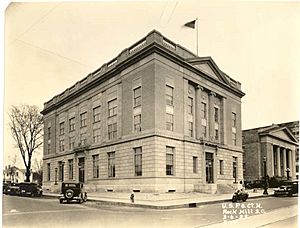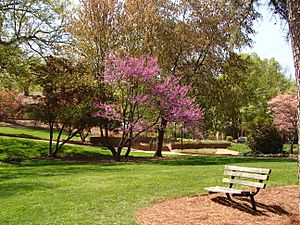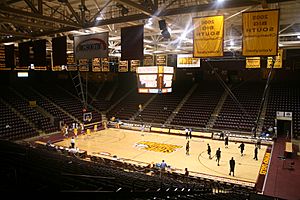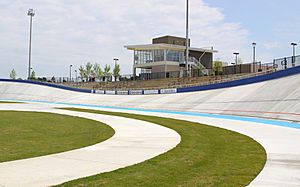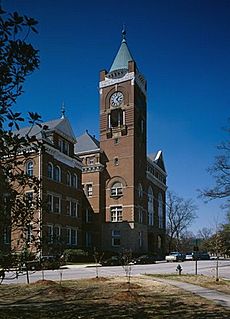Rock Hill, South Carolina facts for kids
Quick facts for kids
Rock Hill, South Carolina
|
|||
|---|---|---|---|
| City of Rock Hill | |||
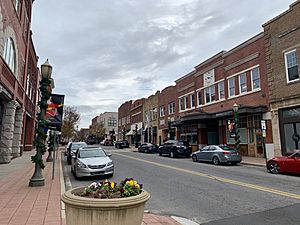
Downtown Rock Hill
|
|||
|
|||
| Nickname(s):
The Gateway to South Carolina; Football City USA
|
|||
| Motto(s):
Always On.
|
|||
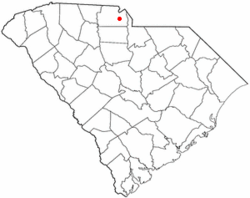
Location of Rock Hill in South Carolina
|
|||
| Country | United States | ||
| State | South Carolina | ||
| County | York | ||
| Founded | 1852 | ||
| Incorporated | 1892 | ||
| Government | |||
| • Type | Judicial | ||
| Area | |||
| • City | 39.14 sq mi (101.38 km2) | ||
| • Land | 38.99 sq mi (100.97 km2) | ||
| • Water | 0.16 sq mi (0.41 km2) 0.4% | ||
| Elevation | 676 ft (206 m) | ||
| Population
(2020)
|
|||
| • City | 74,372 | ||
| • Density | 1,908/sq mi (736.6/km2) | ||
| • Urban | 117,375 | ||
| Demonym(s) | Rock Hillian | ||
| Time zone | UTC−5 (Eastern) | ||
| • Summer (DST) | UTC−4 (Eastern) | ||
| ZIP codes |
29730 29731 29732 29733 29734
|
||
| Area code(s) | 803, 839 | ||
| FIPS code | 45-61405 | ||
| GNIS feature ID | 1250417 | ||
Rock Hill is the largest city in York County, South Carolina, United States, and the fifth-largest city in the state. It is also the fourth-largest city of the Charlotte metropolitan area, behind Charlotte, Concord, and Gastonia (all located in North Carolina, unlike Rock Hill). As of the 2020 Census, the population was 74,372. As of 2017, the total population of the Rock Hill Census County Division was estimated at 117,375 people.
The city is located approximately 25 miles (40 km) south of Charlotte and approximately 70 miles (110 km) north of Columbia.
Rock Hill offers scenic riverfront views along the Catawba River and is home to numerous nature trails, restaurants, and thirty-one parks which are used for both national and local events. Its historic downtown consist of twelve contiguous buildings built as early as 1840 offering dining and retail options. The city is also home to three colleges, including Winthrop University, a public liberal arts university founded in 1886 which enrolls nearly 6,000 students annually.
Contents
History
Pre-colonization
Succeeding cultures of indigenous peoples lived in the Piedmont for thousands of years. The historic Catawba Indian Nation, a traditionally Siouan-speaking tribe, was here at the time of European encounter. Currently the only tribe in South Carolina that is federally recognized, its members live near Rock Hill.
Early colonization
Although some European settlers had already arrived in the Rock Hill area in the 1830s and 1840s, Rock Hill did not become an actual town until the Charlotte and South Carolina Railroad Company made the decision to send a rail line through the area. Originally, the railroad had hoped to build a station in the nearby village of Ebenezerville which was squarely between Charlotte, North Carolina and Columbia, South Carolina. When approached, however, the locals in Ebenezerville refused to have the railroad run through their village since they considered it dirty and noisy. Instead, engineers and surveyors decided to run the line two miles away by a local landmark. According to some accounts, the engineers marked the spot on the map and named it "rocky hill."
Some of Rock Hill's early founding families—the White family, the Black family, and the Moores—believed that having a rail depot so close to them would be advantageous, so they decided to give the Columbia and Charlotte Railroad the right of way through their properties. As the three largest landowners in the area, this settled the matter. George Pendleton White contracted with the railroad to build a section of the line. Construction began in 1848. The first passenger train arrived on March 23, 1852. A few weeks later, on April 17, 1852, the first Rock Hill Post Office opened.
Now that Rock Hill had a name, a railroad station, and a post office, it began to draw more settlers to the area. Captain J. H. McGinnis built a small general store near the station in 1849 or 1850 to provide supplies for the construction and railroad workers. Templeton Black, who had leased the land to McGinnis, decided to devote some of his other adjacent land to building a larger town. He hired a local surveyor, Squire John Roddey, to organize a main street. Black sold his first plot of land along that street to Ira Ferguson for $125 a few weeks before the post office opened; other businessmen bought plots quickly after that.
Rock Hill Academy, the first school in Rock Hill, opened in September 1854. Despite its official name, most residents referred to it as the Pine Grove Academy after the pine grove it was located in. Ann Hutchinson White, wife of George White, donated the land to the school after her husband's death. The school had 60 male pupils in 1856; a school for girls was later opened in the same place.
Other significant facts and dates
- Pre-December 1857: The Indian Land Chronicle, Rock Hill's first newspaper, begins publishing. After a change in ownership, it was renamed The Rock Hill Chronicle in 1860.
- Pre-1860: Rock Hill had at least two doctors: Robert Hervey Hope and William Barron Fewell
During the American Civil War
Shortly before the American Civil War began a census had been taken of the population in York County, where Rock Hill is located. Half of the district's 21,800 residents were slaves, integral to local cotton production. The 4,379 white males in the county formed fourteen infantry companies; some of the men joined cavalry or artillery units instead. By the end of the war, 805 of these men were dead, and hundreds more were wounded. Men from Rock Hill and York County were involved in many of the major Civil War battles.
Due to its position on the railroad, Rock Hill became a transfer point for Confederate soldiers and supplies moving to and from the front. Since there was no local hospital, townspeople nursed sick and wounded soldiers in their homes. Refugees fleeing the coastal blockade or General Sherman's troops also came to Rock Hill.
Beginning in the spring of 1862, local area farmers switched from cotton to corn in order to produce more food. Records show that prices in Rock Hill changed frequently during the war, reflecting both shortages and the inflation of the Confederate paper money.
Confederate General P. G. T. Beauregard set up a temporary headquarters in Rock Hill on February 21, 1865. He ordered the roads to Charlotte blocked to try to prevent General Sherman from reaching the city; Sherman ultimately went in a different direction.
When General Lee surrendered at the Appomattox Court House, it was actually a future Rock Hill resident who was responsible for waving the white flag. Captain Robert Moorman Sims, a farmer from Lancaster County, was sent by General James Longstreet to inform Union troops that the Confederate troops wanted a truce.
Post-Civil War
The Civil War changed the social, economic, and political situation in Rock Hill tremendously, as it did elsewhere in the South. Rock Hill grew as a town, taking in war refugees, widows and their families, and the return of the men who had left to fight the war. The formerly wealthy elite sold off their land to stay afloat financially. Town life began to become more important than rural life.
Most of the merchants in Rock Hill around 1870 were former Confederate soldiers; many were entrepreneurs who were new to town, trying to start over. In 1870, even the largest stores in Rock Hill were only one story tall, and there were no sidewalks on the roads. The first drug store in Rock Hill opened in the 1870s. In 1881 and introduced the town's first paved sidewalk was made.
Incorporation
The town was not officially incorporated until 1870, on the third try.
The first attempt to get Rock Hill incorporated was made in 1855. A petition, signed by major landholders and businessmen from the Rock Hill area, was presented to the General Assembly on October 19, 1855. No action on the matter was taken by the General Assembly.
The second attempt was in 1868. In their petition, the townspeople claimed that Rock Hill had over 300 residents, "eleven stores, two churches, two bars, two hotels, two carriage shops, three blacksmith shops, three shoe shops, one tannery, one cabinet shop, and elementary schools for white girls and boys." The petition was signed by 48 men, most relative newcomers to Rock Hill, with only a few members of the old, established, landed families. The larger landholders opposed incorporation because of the taxes it would bring. They filed a counter-proposal which claimed that there were only 100 residents, many of them temporary. The situation was a strong indication of the changes Rock Hill experienced as it transitioned from mostly farms to a business community. Ultimately, the state legislature did not act on either petition and Rock Hill was still not incorporated.
The third, successful petition was made in 1869, only one year after 1868's failed petition. This time there were 57 signers in favor of incorporation, with only seven opponents. The opponents collectively owned 80% of the land that would be incorporated into Rock Hill if the petition was successful. They were unsuccessful at preventing incorporation this time; Rock Hill was officially incorporated on February 26, 1870.
Twentieth century
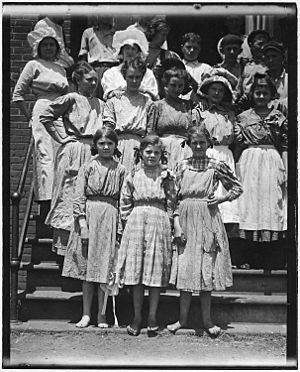
Rock Hill celebrated its centennial in 1952 and its sesquicentennial in 2002.
Four unincorporated communities of York County have been annexed to the city: Boyd Hill in the late 1940s, Ebenezer and Mexico in the 1960s, and Oakdale in the 1980s.
Civil Rights Movement
Rock Hill was the setting for two significant events in the civil rights movement. In February 1961, nine African-American men went to jail at the York County prison farm after staging a sit-in at a segregated McCrory's lunch counter in downtown Rock Hill. Their offense was reported to be "refusing to stop singing hymns during their morning devotions." The event gained nationwide attention as the men followed an untried strategy called "jail, no bail." Rejecting bail was a way to lessen the huge financial burden which civil rights groups were facing as the sit-in movement spread across the South. As their actions gained widespread national news coverage, the tactic was adopted by other civil rights groups. The men became known as the Friendship Nine because eight of the nine men were students at Rock Hill's Friendship Junior College.
Later in 1961, Rock Hill was the first stop in the Deep South for a group of 13 Freedom Riders, who boarded buses in Washington, DC, and headed South to test the 1960 ruling by the U.S. Supreme Court outlawing racial segregation in all interstate public facilities. When the civil rights leader John Lewis and another black man stepped off the bus at Rock Hill, they were beaten by a white mob that was uncontrolled by police. The event drew national attention.
In 2002, Lewis, by then a US Congressman from Georgia, returned to Rock Hill, where he had been invited as a speaker at Winthrop University and was given the key to the city. On January 21, 2008, Rep. Lewis returned to Rock Hill again and spoke at the city's Martin Luther King, Jr. holiday observance. Mayor Doug Echols officially apologized to him on the city's behalf for the Freedom Riders' treatment in the city.
1926 Rock Hill tornado
On November 26, 1926 a destructive tornado struck downtown Rock Hill. It was the day after Thanksgiving, late in the season for such a violent storm. The "black as ink twister" took less than 10 minutes to change the face of the business section. The storm touched down in western York County, and entered Rock Hill from the west. Once in the town, the twister cut a path about three blocks wide, leaving 60 homes heavily damaged, the hospital roof removed, and cars flipped or crushed. By the end, the total damage for the whole town was $150,000. The tornado was responsible for one death and 12 injuries within Rock Hill.
Hurricane Hugo
Hurricane Hugo struck the city on the morning of September 22, 1989. The storm ripped through the city with sustained winds over 90 MPH, toppling massive oak and pine trees. Schools were closed for weeks because of widespread damage to roads and facilities. The total damage cost for the entire state of South Carolina was around $4.2 billion. The storm was a category 3 when it entered the county and was a category 2 as it left the county.
2004 blizzard
A complex series of low pressure systems moved across South Carolina from February 25–27 of 2004. Starting as a mix of snow and sleet, the storm became all snow as the low pulled off the Carolina coast. Cold arctic air settled over the Carolinas and dumped 22 inches of snow, with lightning, gusty winds, and some areas getting up to 28 inches. Sustained winds over 40 MPH across Rock Hill knocked out power, resulting in schools' closing for a week. It was the worst overall blizzard to hit the area.
Transportation
Highway
From locations across the country, Rock Hill is most easily accessible by interstate highway.
- Interstate 77: Exit numbers 73–82
- Interstate 85: Exit number 102
Air
Rock Hill has two local airports. The Rock Hill/York County Airport is a municipal airport for the city of Rock Hill and serves non-commercial flights. The airport is located minutes from Rock Hill's Central business district. Also called Bryant Field, it was named for Robert E. Bryant, an aviator with two international records and an inductee in the South Carolina Aviation Hall of Fame (The name is no longer used for the airport because of confusion with Bryant Field (airport)). It is owned and operated by the City of Rock Hill, but York County is also represented on the Airport Commission.
The other local airport, the Charlotte-Douglas International Airport, is one of the busiest airports in the United States and is located 20 miles north of Rock Hill in Charlotte, North Carolina.
Public transportation
Rock Hill has one regional transit system, The Charlotte Area Transit System that offers express bus service from downtown Rock Hill to Uptown Charlotte.
- 82X Downtown Rock Hill to Manchester Village to Uptown Charlotte.
Rock Hill currently offers My Ride, an electric bus transit service
Bike
Rock Hill is considered to be a bicycle-friendly town with numerous bike routes located throughout the city. There are also designated bike lanes located along major roads such as Eden Terrace and Oakland Avenue.
Arts and culture
Seasonal events
Rock Hill hosts several seasonal events. Each spring there is a festival called Come-See-Me which brings more than 125,000 people to the city each year from across the country. Come-See-Me was voted as the number one South Carolina Festival and has been featured in Southern Living magazine. On Independence Day, Rock Hill hosts its annual Red, White, and Boom Festival. Over the first weekend of each October, the Arts Council of York County hosts the Blues & Jazz Festival, which includes a restaurant crawl through Old Town Rock Hill, and a day of blues & jazz events for children. In November, the Arts Council hosts the Underexposed Film Festival YC, bringing independently-created short films from across the world to Rock Hill. A winter festival is held annually in the first week of December and is called ChristmasVille Rock Hill; it has been voted one of South Carolina's most visited attractions.
Museums

Five museums are located in the city, and many more in the area.
- The York County Museum of Rock Hill is a cultural and natural history museum located near the Rock Hill Airport.
- The Comporium Telephone Museum is a historical museum located in Downtown about the history of technology in Rock Hill.
- The Center for the Arts is an art museum also located in Downtown and owned by the York County Arts Council viewing local art.
- The Main Street Children's Museum is located in Downtown as well, specializing in children's learning and educational activities.
- The White Home is a museum and park on White Street and is on the National Register of Historical Places.
Museums outside Rock Hill include Historic Brattonsville, the Catawba Cultural Center at the Catawba Indian reservation, and several museums located in the Charlotte area.
Parks and recreation
Rock Hill is home to thirty-one parks, four recreational centers, one botanical garden, along with the many nature trails.
There are also Nanny Mountain County Park and Ebenezer County Park, Kings Mountain State Park, Andrew Jackson State Park, and Kings Mountain National Military Park nearby.
In popular culture
Films
- The Patriot (2000 film), rural Rock Hill, starring Mel Gibson, Heath Ledger
- Black Rainbow
- The Rage: Carrie 2
- Asylum (2008 film), at Winthrop University
- Walker Payne 2006
- Gospel Hill 2008
- One Church
Awards
Rock Hill is a four-time winner of America's Promise Alliance "100 Best Communities for Young People", and a previous winner of the National Civic League's All-America City Award.
Economy
| 3D Systems |
| Amida Industries, INC. |
| Carolina Energy |
| City of Rock Hill |
| Comporium Communications |
| Cytec Carbon Filters, LLC. |
| Hyosung Corporation |
| Langer Transport Corporation |
| Rock Hill Schools |
| Winthrop University |
Rock Hill's economy was once dominated by the textile industry, and the restructuring of that industry in moving jobs overseas caused a decline in the local economy at one time. Over the past decade, Rock Hill has transitioned to a relatively strong manufacturing workforce.
Other major companies in Rock Hill with headquarters or North American headquarters include Hyosung, Comporium Communications, 3D Systems, Atlas Copco, and The Carolina Panthers.
The median income for a household in the city was $37,336, and the median income for a family was $45,697. Males had a median income of $32,156 versus $24,181 for females. The per capita income for the city was $18,929. About 9.7% of families and 14.0% of the population were below the poverty line, including 16.2% of those under age 18 and 12.0% of those age 65 or over. The unemployment rate of the city was 8.7 percent and 11,874 of the 71,459 residents lived and worked in the city with a daytime population change of +5,208 as of March 2011. The city is transitioning to a retail and manufacturing economy, and has been working to attract national and global companies.
Shopping
- Rock Hill Galleria is a regional shopping mall anchored by Belk, JC Penney, Walmart, along with around 50 specialty stores and a food court.
- Manchester Village is another shopping center. The complex is anchored by nine national retailers, a Regal 14-screen movie theater, and many other specialty shops.
- Riverwalk is a mixed-use community consisting of specialty stores and restaurants located along the Catawba River on the eastern city boundary.
Demographics
| Historical population | |||
|---|---|---|---|
| Census | Pop. | %± | |
| 1880 | 809 | — | |
| 1890 | 2,744 | 239.2% | |
| 1900 | 5,485 | 99.9% | |
| 1910 | 7,216 | 31.6% | |
| 1920 | 8,809 | 22.1% | |
| 1930 | 11,322 | 28.5% | |
| 1940 | 15,009 | 32.6% | |
| 1950 | 24,502 | 63.2% | |
| 1960 | 29,404 | 20.0% | |
| 1970 | 33,846 | 15.1% | |
| 1980 | 35,327 | 4.4% | |
| 1990 | 41,643 | 17.9% | |
| 2000 | 49,765 | 19.5% | |
| 2010 | 66,154 | 32.9% | |
| 2020 | 74,372 | 12.4% | |
| U.S. Decennial Census | |||
2020 census
| Race | Num. | Perc. |
|---|---|---|
| White (non-Hispanic) | 35,264 | 47.42% |
| Black or African American (non-Hispanic) | 28,580 | 38.43% |
| Native American | 283 | 0.38% |
| Asian | 1,471 | 1.98% |
| Pacific Islander | 55 | 0.07% |
| Other/Mixed | 2,962 | 3.98% |
| Hispanic or Latino | 5,757 | 7.74% |
As of the 2020 United States census, there were 74,372 people, 32,341 households, and 18,379 families residing in the city.
2010 census
As of the 2010 census, there were 66,154 people and 16,059 families residing in the city. The population density was 619.2 people per square kilometre (2,983.5/sq mi). There were 29,159 housing units at an average density of 252.4 per square kilometre (653.8/sq mi). The racial makeup of the city was 54.6% White, 38.3% Black, 1.7% Asian, 0.5% Native American, 0.1% Pacific Islander, 2.7% from other races, and 2.1% from two or more races. Hispanic or Latino of any race were 5.7% of the population.
There were 25,966 households, out of which 29.9% had children under the age of 18 living with them, 38.1% were married couples living together, 18.8% had a female householder with no husband present, and 38.2% were non-families. 30.3% of all households were made up of individuals, and 8.6% had someone living alone who was 65 years of age or older. The average household size was 2.43 and the average family size was 3.04.
In the city, the population was spread out, with 24.4% under the age of 18, 14.7% from 18 to 24, 28.5% from 25 to 44, 22.0% from 45 to 64, and 10.4% who were 65 years of age or older. The median age was 31.9 years. For every 100 females, there were 85.3 males. For every 100 females age 18 and over, there were 80.3 males.
Sports
Rock Hill hosts two national championships, the United States Disc Golf Championship at Winthrop University, and the US Youth Soccer National Championships at Manchester Meadows Soccer Complex.
Rock Hill hosted the 2015 IQA World Cup, making it the second consecutive year South Carolina hosted the Quidditch World Cup.
Rock Hill hosted the 2017 UCI BMX World Championships in July 2017 at the Riverwalk mixed-use community along the Catawba River.
Collegiate sports include the Winthrop University Eagles, a National Collegiate Athletic Association (NCAA) Division I team.
Former sports teams include the Rock Hill Cardinals, a Western Carolinas League baseball team affiliated with the St. Louis Cardinals that existed from 1963 to 1968.
In 2019, Rock Hill was selected as the site for the Carolina Panthers' 200 acre training facility.
Education
K–12
Public education in Rock Hill is administered by York County School District 3. The district operates twenty-seven schools in the city, including nineteen elementary schools, five middle schools, and three high schools. The district has a student enrollment of around 25,000.
High schools
- Rock Hill High School (first built high school in the city)
- Northwestern (built at the time of school integration in 1970, replacing all-black Emmett Scott High School)
- South Pointe (the newest high school in the city)
Middle schools
- Saluda Trail Middle School
- Castle Heights Middle School
- Sullivan Middle School
- Rawlinson Road Middle School
- Dutchman Creek Middle School
- Westminster Catawba Christian School
Private schools
A variety of religious schools serve the city of Rock Hill, including St. Anne's Catholic School and Westminster Catawba. The city is also home to two Charter schools: York Preparatory Academy, and Legion Collegiate Academy.
Higher education
There are three colleges in Rock Hill.
The most prominent institution is Winthrop University, founded in 1886 as a women's college. It is a thriving, public, co-ed four-year comprehensive university with an annual enrollment of about 6,000 students.
Clinton College is a historically black founded by the African Methodist Episcopal Zion Church in 1894. Initially a two-year institution, the liberal arts college added four-year degree programs in 2013 in addition to the associate degree programs.
York Technical College opened in Rock Hill in 1964. This two-year community college offers associate degrees and provides continuing education for approximately 9,000 area residents annually and is growing each year.
Library
Rock Hill has a public library, a branch of the York County Library.
Notable people
- Robert O'Neil Bristow, award winning American novelist
- Patrick Caddell served in the Jimmy Carter administration, and was a public opinion pollster and a political consultant was born and raised in Rock Hill
- Lauren Cholewinski, Olympic speedskater
- Matt Christopher, children's sports author
- Lafayette Currence, baseball player
- Ed Currie, grew some of the world's hottest peppers, such as the Carolina Reaper and Pepper X
- Emery, nationally known emo band
- William G. Enloe, mayor of Raleigh, North Carolina
- DJ Felli Fel, charted on the Hot 100 with "Get Buck in Here" 2007
- Vernon Grant, commercial artist and creator of the Snap, Crackle and Pop characters for Kellogg's Rice Krispies cereal
- Jim Hoagland, journalist and a two-time Pulitzer Prize winner
- Ironing Board Sam, blues keyboardist
- Cheslie Kryst, Miss USA 2019
- Edmund Lewandowski, Precisionist movement artist, chairman of the art department at Winthrop, from 1973 to 1984
- William Ivey Long, Tony Award-winning costume designer
- Ralph Norman, U.S. Representative
- Jim Ray, Major League Baseball pitcher
- Leon Rippy, actor in The Patriot
- Justin Worley, former QB for the University of Tennessee
National Football League players
- Phillip Adams
- Jeff Burris – former NFL player currently the cornerbacks coach at Louisiana Tech
- Jadeveon Clowney – currently an outside linebacker for the Cleveland Browns
- Gerald Dixon – former NFL linebacker for multiple teams
- Stephon Gilmore – 2019 AP NFL Defensive Player of the Year, currently a cornerback for the Indianapolis Colts
- Tori Gurley – former football player in the NFL and CFL
- Jonathan Hefney – former football player in the NFL and CFL
- DeVonte Holloman - former football player in the NFL
- Chris Hope – former NFL player and pro bowler
- Johnathan Joseph – currently a cornerback for the Houston Texans
- Spencer Lanning – former punter in the NFL
- Robert Massey – former NFL cornerback for multiple teams
- Jonathan Meeks – NFL safety that is currently a free agent
- Cordarrelle Patterson – current wide receiver for the Atlanta Falcons
- Derek Ross – former cornerback for multiple teams in the NFL
- Mason Rudolph – currently a quarterback for the Pittsburgh Steelers
- Rick Sanford – former defensive back for the New England Patriots and Seattle Seahawks
- Jaleel Scott – currently a free agent wide receiver
- Ko Simpson – former safety in the NFL
- Benjamin Watson – former tight end for the New England Patriots and New Orleans Saints
Images for kids
See also
 In Spanish: Rock Hill (Carolina del Sur) para niños
In Spanish: Rock Hill (Carolina del Sur) para niños



